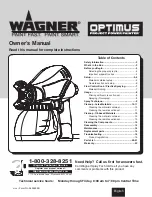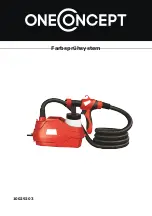
17
307-785
3
The motor will not operate.
PROBLEM
WHAT TO CHECK
If check is OK, go to next check
WHAT TO DO
When check is not OK refer to this column
Remove the gun from
the hose. Remove the
pressure control cover.
Check for a faulty condi-
1. Check the leads from the bridge (308) to the
motor to be sure the leads are securely fas-
tened and properly mated.
1. Replace any loose terminals. Crimp the
leads. Be sure male terminal blades are
straight and firmly connected to mating part.
Check for a faulty condi-
tion of the circuit board
lamps.
Condition A
2. Check the G1 and G2 connections between
the circuit board (23) and the bridge (308) for
damage or loose terminals.
2. Clean circuit board male terminals. Replace
loose or damaged terminals. Securely re-
connect leads.
Condition A
Both lamps on, but the
pump won’t operate
and the motor is not
3. Check for loose connections and terminals on
the motor brushes. See page 25.
3. Tighten terminal screws. Replace brushes if
leads are damaged. See page 25.
and the motor is not
operating.
4. Check both of the the brushes. The brush
length should be at least 1/2 inch (12 mm)
long. See page 25.
4. Replace brushes. See page 25.
5. Check for a broken or a misaligned motor
brush spring. The rolled portion of the spring
must rest squarely on top of the brush. See
page 25.
5. Replace spring if broken. Realign spring
with brush. See page 25.
6. Check to see if the motor brushes are binding
in the brush holders. See page 25.
6. Clean the brush holders, using a small
cleaning brush. Align the brush leads with
the slot in the brush holder to assure vertical
brush movement.
7. Check the motor’s commutator for burn spots,
gouges, and extreme roughness. See page
25.
7. Remove the motor and have a motor shop
resurface the commutator, if possible. See
page 34.
8. Use an armature tester or perform the sping
test to check the motor armature for electrical
shorts. See page 22.
8. Replace the motor. See page 34.
9. Check the bridge (308) by substituting it with a
good bridge or performing the bridge test. See
page 23.
CAUTION: Do not perform this check until
the motor armature is determined to be good. A
bad armature will immediately burn out a good
bridge.
9. Replace the bridge. See page 27.
Condition B:
Both lamps are off.
Refer to the wiring dia
-
18 t
1. Check the circuit breaker (309) button to be
sure it has not popped up.
1. Depress the button to reset the circuit
breaker. If circuit breaker or fuse continues
to open, see, “There is an electrical short.”
on page 21.
Refer to the wiring dia
gram on page 18 to
identify the test pointS
(TP).
NOTE: Connect the volt
meter to the terminal, not
t th
i
hi h
2. Check the power cord (311). Disconnect the
TP6 female (neutral) and the TP1 female. Con-
nect a volt meter to these leads. Plug in the
sprayer. The meter should read 105 to 125
VAC. Unplug the sprayer. Reconnect the TP1.
2. Replace the power cord. See page 26.
meter to the terminal, not
to the wire which you
disconnect from the ter-
minal.
3. Check the ON/OFF switch (303). Disconnect
the TP2 and connect the volt meter to the TP6
female and the TP2 male. Plug in and turn on
the sprayer. The meter should read 105 to 125
VAC. Turn off and unplug the sprayer. Recon-
nect theTP2.
3. Replace the ON/OFF switch. See page 26.
4. Check the jumper wire (306). Disconnect the
TP3. Connect a volt meter between TP6 fe-
male and TP3 female. Plug in and turn on the
sprayer. The meter should read 105 to 125
VAC. Turn off and unplug the sprayer. Recon-
nect theTP3.
4. Replace the jumper wire. See page 26.
5. Check the circuit breaker (309). Connect a volt
meter between TP6 female and TP4. Plug in
and turn on the sprayer. The meter should
read 105 to 125 VAC. Turn off and unplug the
sprayer.
5. Replace the circuit breaker. See page 27.
Содержание Ultra 1000
Страница 45: ...45 307 785 Notes ...
Страница 46: ...46 307 785 Notes ...
















































